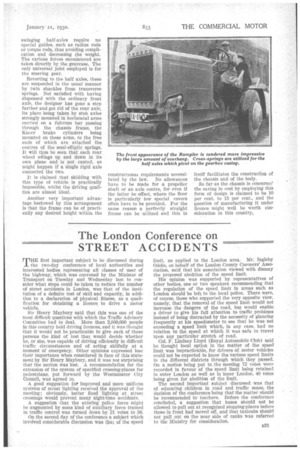The London Conference on STREET ACCIDENTS
Page 57

If you've noticed an error in this article please click here to report it so we can fix it.
THE first important subject to be discussed during the two-day conference of local authorities and interested bodies representing all classes of user of the highway, which was convened by the Minister of Transport on Tuesday and Wednesday last to consider what steps could be taken to reduce the number of street accidents in London, was that of the institution of a definite test of skill and capacity, in addition to a declaration of physical fitness, as a qualification for obtaining a licence to drive a motor vehicle.
Sir Henry .Maybury said that this was one of the most difficult questions with which the Traffic Advisory Committee had to deal. More than 2,000,000 people in this country hold driving licences, and it was thought that it would not be practicable to give each of these persons the kind of test that would decide whether he, or she, was capable of driving efficiently in difficult traffic circumstances and of acting skilfully at a moment of emergency. Other opinions expressed lose their importance when considered in face of this statement by Sir Henry Maybury, and it was not surprising that the motion was lost. A recommendation for the extension of the system of specified crossing-places for pedestrians, put forward by the Westminster City Council, was agreed to.
A good suggestion for improved and more uniform systems of street lighting received the approval of the meeting; obviously, better Rood lighting at street crossings would prevent many night-time accidents.
A suggestion that the existing police force might he augmented by some kind of auxiliary force trained in traffic control was turned down by 51 votes to 38. On the second day of the conference a subject which involved considerable discussion was tat of the speed
limit, as applied to the London area. Mr. Ingleby Oddie, on behalf of the London County Coroners' Association, said that his association viewed with dismay the proposed abolition of the speed limit.
His opinion was supported by representatives of other bodies, one or two speakers recommending that the regulation of the speed limit in areas such as London should be left to the local police. There were, of course, those who supported the very opposite view, namely, that the removal of the peed lirait would not increase the dangers of the road, but would enable a driver to give his full attention to traffic problems instead of being distracted by the necessity of glancing frequently at his speedometer to see that he was not exceeding a speed limit which, in any case, had no relation to the speed at which it was safe to travel upon any particular stretch of road. Col. F. Lindsay Lloyd (Royal Automobile Club) said he thought local option in the matter of the speed limit was impracticable, for drivers of motor vehicles could not be expected to know the various speed limits in the different districts through which they passed. On a motion being put to the meeting 72 votes were recorded in favour of the speed limit being retained in outer London as well as in inner London, 40 votes being given for abolition of the limit.
The second important subject discussed was that of educating children in road and traffic sense, the decision of the conference being that the matter should be recommended to teachers. Belore the conference concluded, a suggestion that buses should not be allowed to pull out at recognized stopping-places before• those in front had moved off, and that taxicabs should not pull out on the near side of ranks was referred to the Ministry for consideration.




















































































































